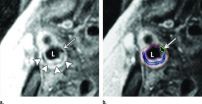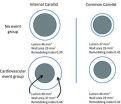(Press-News.org) OAK BROOK, Ill. – Noninvasive imaging of carotid artery plaque with MRI can accurately predict future cardiovascular events like strokes and heart attacks in people without a history of cardiovascular disease, according to a new study published online in the journal Radiology.
Researchers have long known that some arterial plaque is more dangerous because of its vulnerability to rupture. MRI can discern features of vulnerable plaque, such as a lipid core with a thin fibrous cap. This ability makes MRI a potentially valuable tool for identifying patients at risk for subsequent cardiovascular events.
To study the predictive value of MRI plaque imaging, researchers performed carotid artery ultrasound and MRI on 946 asymptomatic patients from the Multi-Ethnic Study of Atherosclerosis (MESA). The carotid arteries are the large vessels located on each side of the neck that carry oxygenated blood to the front part of the brain. They are highly accessible for imaging, and their condition tends to mirror that of the coronary arteries that supply the heart with oxygenated blood.
The researchers used ultrasound to assess carotid wall thickness and MRI to define carotid plaque composition and the remodeling index, a measure of changes in vessel size. Imaging results were compared with cardiovascular events, including heart attacks, stroke and death, for an average of 5.5 years after examination.
"We studied asymptomatic individuals with a low risk of cardiovascular events at baseline and used noninvasive imaging to predict the risk of an event downstream," said David A. Bluemke, M.D, Ph.D., from the National Institutes of Health Clinical Center in Bethesda, Md. "This is the first population-based prospective study to determine if vulnerable plaque features by MRI add to the risk of a cardiovascular event beyond the traditional risk factors."
Cardiovascular events occurred in 59 of the patients. Abnormal thickening of the carotid artery wall and the presence of a lipid core and calcium in the internal carotid artery on MRI were significant predictors of subsequent events. A lipid core was present in almost half of the patients who had an event, compared with only 17.8 percent of those who did not have an event.
"The primary factors that predicted future risk were measures of vessel wall thickness in combination with the presence or absence of a lipid core," Dr. Bluemke said. "The presence of a lipid core was 50 percent more common in people who had subsequent events."
Use of MRI improved the reclassification of baseline cardiovascular risk in the study group. When both the carotid remodeling index and lipid core were used for risk stratification, approximately 16 percent more patients with events and 7 percent without events were correctly reclassified compared with the use of traditional risk factors.
"The results bolster the use of MRI as a surrogate marker of efficacy in therapeutic studies and point to a role in determining which patients might need more aggressive treatments," Dr. Bluemke said. "As risk factor prediction gets better, we'll be able to screen more intelligently and use more intensive treatments in those individuals who face a higher risk of cardiovascular events."
Dr. Bluemke noted that sequences for plaque composition could be readily added to existing carotid MRI angiography protocols for clinical purposes.
"Carotid MRI has significant advantages," he said. "The results are more reproducible than those of ultrasound."
Availability and cost effectiveness could limit the use of MRI, Dr. Bluemke cautioned. However, ultrasound and computed tomography (CT) are viable alternatives for screening, he said, especially with improvements in CT dose reduction.
INFORMATION:
"Carotid Artery Plaque Morphology and Composition in Relation to Incident Cardiovascular Events: The Multi-Ethnic Study of Atherosclerosis (MESA)." Collaborating with Dr. Bluemke were Anna E. H. Zavodni, M.D., Bruce A. Wasserman, M.D., Robyn L. McClelland, Ph.D., Antoinette S. Gomes, M.D., Aaron R. Folsom, M.D., M.P.H., Joseph F. Polak, M.D., M.P.H., and João A. C. Lima, M.D.
Radiology is edited by Herbert Y. Kressel, M.D., Harvard Medical School, Boston, Mass., and owned and published by the Radiological Society of North America, Inc.
RSNA is an association of more than 53,000 radiologists, radiation oncologists, medical physicists and related scientists promoting excellence in patient care and health care delivery through education, research and technologic innovation. The Society is based in Oak Brook, Ill.
For patient-friendly information on MRI, visit RadiologyInfo.org.
Carotid Artery MRI helps predict likelihood of strokes and heart attacks
2014-03-04
ELSE PRESS RELEASES FROM THIS DATE:
USDA school meal standards positively impact low-income students' fruit and vegetable consumption
2014-03-04
Ann Arbor, MI, March 4, 2014 – With nearly 32 million American students receiving government-subsidized meals every day, getting children the nutrition they need is a priority for schools as well as legislators. In the fall of 2012, revamped school lunch guidelines from the U.S. Department of Agriculture (USDA) went into effect. New standards necessitate increased availability of whole grains, fruits, and vegetables, require students to select either a fruit or vegetable as one of their lunch items, and mandate larger portion sizes for fruits and vegetables.
Initially, ...
New school meal standards significantly increase fruit, vegetable consumption
2014-03-04
Boston, MA -- New federal standards launched in 2012 that require schools to offer healthier meals have led to increased fruit and vegetable consumption, according to a new study from Harvard School of Public Health (HSPH) researchers. The study, the first to examine school food consumption both before and after the standards went into effect, contradicts criticisms that the new standards have increased food waste.
"There is a push from some organizations and lawmakers to weaken the new standards. We hope the findings, which show that students are consuming more fruits ...
Gonorrhea infections start from exposure to seminal fluid
2014-03-04
Researchers have come a step closer to understanding how gonorrhea infections are transmitted. When Neisseria gonorrhoeae, the bacteria responsible for gonorrhea, are exposed to seminal plasma, the liquid part of semen containing secretions from the male genital tract, they can more easily move and start to colonize. The research, led by investigators at Northwestern University in Chicago, appears in mBio®, the online open-access journal of the American Society for Microbiology.
"Our study illustrates an aspect of biology that was previously unknown," says lead study ...
Annals of Internal Medicine tip sheet for March 3, 2014
2014-03-04
1. Study of highly-motivated GenX physicians shows that women spend more time than men on parenting and household labor
A survey of high-achieving young physician-researchers shows pronounced gender differences in domestic activities among those married with children, according to an article being published in Annals of Internal Medicine. It is known that female physician-researchers do not achieve career success at the same rate as men. Could differences in nonprofessional responsibilities explain some of the gap? Researchers surveyed 1,055 physician-researchers who ...
BPA linked to prostate cancer, study shows
2014-03-04
CINCINNATI—Findings by Cincinnati Cancer Center researchers show that levels of bisphenol A (BPA) in men's urine could be a marker of prostate cancer and that low levels of BPA exposure can cause cellular changes in both non-malignant and malignant prostate cells.
This research, published in the March 3 edition of PLOS ONE, provides the first evidence that urinary BPA levels may help predict prostate cancer and that disruption of a cell duplication cycle through exposure to low-dose BPA may cause cancer development in the prostate.
BPA, an environmental pollutant ...
Female doctors spend more time than male doctors on parenting, household tasks, study finds
2014-03-04
ANN ARBOR, Mich. — A new study finds gender differences in parenting and household labor persist among a group of highly motivated physician-researchers in the early stages of their career.
The finding could shed light on why female academic physicians in general do not have the same career success as their male colleagues.
"One might expect that within a highly educated Generation X population there would be a relatively even distribution of domestic labor. But what we found was that there still seems to be a difference in the expectations at home for men and women, ...
Unmasking the secrets of the extinct moa
2014-03-04
Griffith researchers have undertaken a study to clarify the number of species which existed of the extinct New Zealand moa.
The findings have been published in 'Complex species status for extinct moa (Aves: Dinornithiformes) from the genus Euryapteryx', in the open access journal PLOS ONE.
Lead author Dr Huynen said the challenges of understanding extinct fauna can be formidable and particularly so when it comes to this ancient bird.
"Despite more than 100 years of research being devoted to the issue, determining species status is challenging, especially where there ...
Blasts may cause brain injury even without symptoms
2014-03-04
DURHAM, N.C. -- Veterans exposed to explosions who do not report symptoms of traumatic brain injury (TBI) may still have damage to the brain's white matter comparable to veterans with TBI, according to researchers at Duke Medicine and the U.S. Department of Veterans Affairs.
The findings, published in the Journal of Head Trauma Rehabilitation on March 3, 2014, suggest that a lack of clear TBI symptoms following an explosion may not accurately reflect the extent of brain injury.
Veterans of recent military conflicts in Iraq and Afghanistan often have a history of exposure ...
Blurred Lines? Sexual boundaries are not really all that blurred
2014-03-03
Sexual aggression has become a common experience in bars.
New findings show that approximately 90 percent of the incidents involve male initiators and female targets.
The initiators' level of invasiveness was related to intoxication of the targets but not their own intoxication.
This suggests that intoxicated women were being targeted, perhaps perceived as easier or more blameworthy.
Meeting people within a bar scene is not usually difficult. Unfortunately, not all contact – whether romantic or sexual – is positive or consensual. In fact, sexual aggression has ...
Hangovers do not seem to have much influence on the time to next drink
2014-03-03
Many people believe that hangovers can either delay subsequent drinking due to pain and discomfort, or hasten drinking to relieve hangover symptoms.
A new study investigates if a hangover that follows a drinking episode can influence the time to next drink.
Results indicate that hangovers appear to have a very modest effect on subsequent drinking.
Many if not most people during their lives have experienced a hangover. Some people believe that hangovers might delay subsequent drinking through pain and discomfort, or perhaps hasten drinking to relieve hangover symptoms, ...


